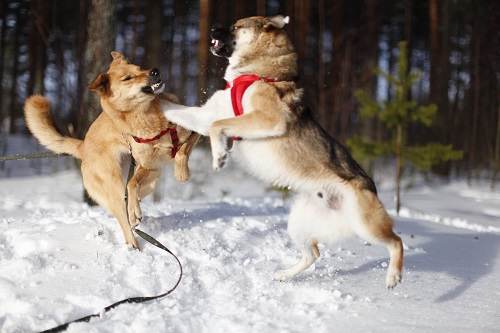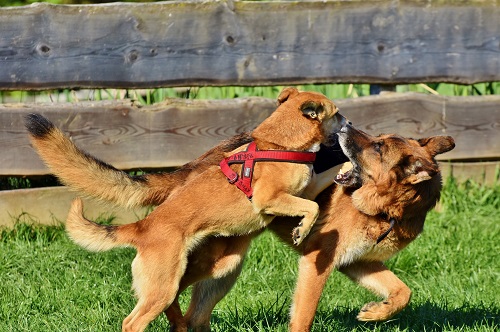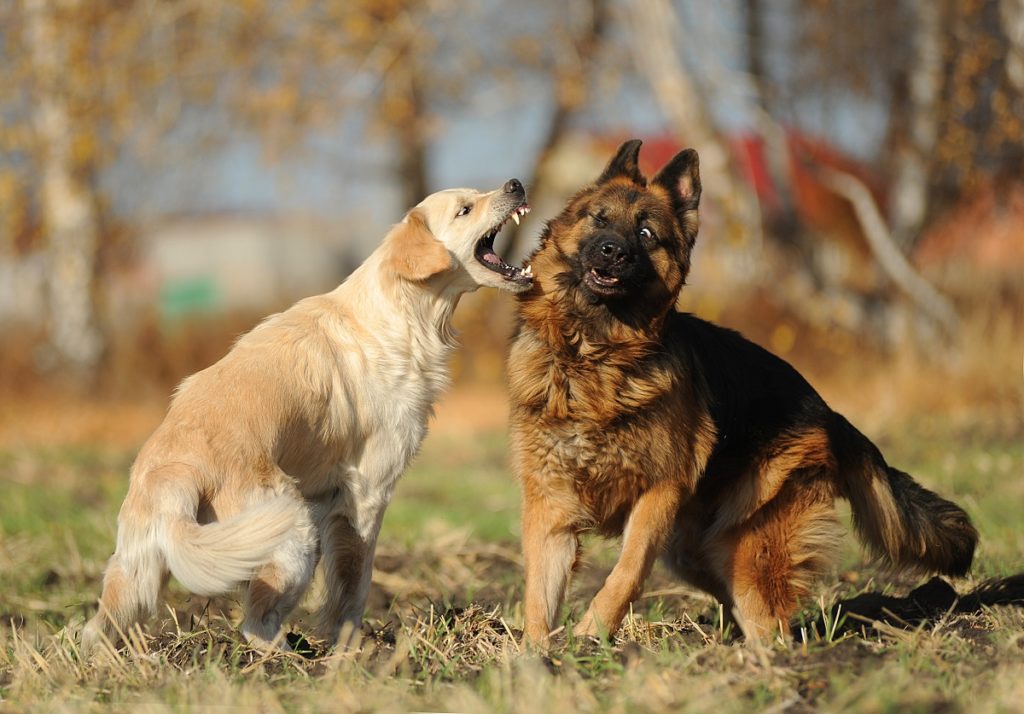Pet parents feel a lot of things towards their beloved canine companion: warmth and love, exasperation when he digs in the garden or garbage, and concern for his health and well-being. That worry for his health manifests in carefully choosing dog food brands, adding helpful supplements to his diet, and making sure he gets plenty of exercise – but sometimes, disaster can strike when you least expect it.
Out on a walk, out in the dog park, or on an “unauthorized excursion” after slipping through the fence: he’s just been bitten. It probably happened very quickly, and despite the quick reaction of his owner, he appears to be hurt or even bleeding. Tempers are high, panic is setting in, and what happens next is extremely important for all humans and animals involved in the scuffle. If your dog was attacked, take a deep breath, a good long look at the situation, and follow these four steps to help de-escalate a tense canine standoff:
Dog Attacked By Another Dog: What to Do?
- Step One: Stop The Fight & Remove Danger: In a situation where two dogs have collided and started fighting, the first priority is to separate them. It’s very important that the owner(s) attempting to do so protect themselves from being bitten, as even their own dog may bite them by mistake in agitation. Under no circumstances should a bare hand or arm be thrust between two dogs biting at each other – this will almost always make the situation worse and provoke injuries. If the bitten dog is collared and leashed, pull back on the leash and immediately put as much distance as possible between the bitten dog and the biting dog, while instructing the other dog owner to do the same.
One of the main reasons dogs become aggressive is when they feel their space or territory is being violated. This may stem from anxiety at a new dog park or dog park attendee, anger over another dog approaching a toy or their owner, or another dog getting too friendly too quickly. While no measure, even distancing the two dogs, is guaranteed to work, it’s the best place to start. At the minimum, it will prevent further lunges and retaliation while both dog parents assess any injuries.
- Step Two: Check For Wounds: Dogs with fluffy coats have a good deal of built-in cushioning when it comes to injuries, including bites. Sometimes what looks to be a biter-bitten situation turns out to be more of a snap-and-snarl affair – all bark, no bite. If blood is spotted, use tissues to blot and locate the source of the wound, as the blood may be from the other dog. If the wound looks to be superficial and the dog is moving and acting normally, it may be the equivalent of a scratch. If the wound is deeper and clearly a bite mark, or if the bleeding is ongoing and dark, it’s crucial to get to an emergency vet immediately.
No matter how shallow or deep wounds are, if wounds are present, information should be exchanged between owners. The way a bitten dog is assessed and treated at a medical level directly depends on the vaccination history of both dogs. If the bitten dog hasn’t been vaccinated, he’ll need to be treated and quarantined for a specific period of time to rule out canine rabies and other serious communicable diseases. If the biting dog hasn’t been vaccinated, he will likely also be isolated for observation, even if he wasn’t bitten in return.
- Step Three: Report The Incident
If actual biting has occurred between two dogs, and the biting was an act of aggression, a police report should be made. While there needs to be some personal judgement as to when this is appropriate – for example, a snap-and-snarl situation between neighbor’s dogs might not warrant a call if everyone is apologetic, vaccinated, and on the same page. In general, though, a strange dog attacking another is a worrisome incident.
Biting may indicate the dog has vicious tendencies, or has been trained or abused to be aggressive and dangerous. While it might be a small scuffle with another dog today, tomorrow it might be serious injuries to a curious toddler, or bite wounds on an adult that moved the wrong way at the wrong time. It is normal and natural to hesitate about making the call: one pet parent never wants to put another in a situation where they could lose their dog, even if it bit another dog. However, it’s necessary to call for the safety of other people, other dogs, and potentially even the biting dog’s owner.
- Step Four: Care For The Bitten Dog: Vets can be difficult to schedule and hard on the budget, but don’t be tempted to skip the trip in a bitten dog situation. Treat a dog bite wound the way one would a snakebite: perhaps the snake wasn’t venomous, and perhaps it didn’t bite down hard, but it’s not worth a dog risking his life to find out. Even rabid dogs can seem perfectly normal for days – eating, drinking, and acting affectionate – before they start to lose control as the symptoms set in. Failing to treat a bitten dog immediately could put an entire household – children included – at risk for being bitten as well.
Follow the vet’s instructions closely and monitor the bitten dog as he begins to heal. Take particular note of his hunger and thirst – if your dog isn’t eating or drinking when he should be, it’s a telltale sign he may have an infection or medical complication from the bite. Give the dog a safe, comfortable, quiet place to sleep and heal and instruct friends and family not to bother him until he’s back up and steady on his four feet.
Handling The Human Side Of Dog Bites
A dog is an undeniable member of the family for most owners, so it’s only natural that emotions run very high when anything happens to him. When a strange dog bites him, the first emotion that a pet parent will typically have is anger. The rage at another dog biting a pet that is deeply loved and cared about can turn the recovery into a very difficult process, rife with a lot of finger pointing, threats, and potentially even lawsuits.
- Exchange information: Ask for the other dog owner’s full legal name, phone number, and address. If they refuse to hand it over, quietly take out a smartphone and take as many pictures and videos as possible to show the police when they arrive. Information like the biting dog’s breed, coloring, collar description, and so on will help when creating the police report.
- Take pictures or video of any wounds: Dogs heal very quickly, and fur coats can make it hard to track healing or original wound sites. Photos and
 videos will help a vet assess the situation before a physical appointment, provided they can be emailed remotely. These may also be used to prove fault or damages if the situation leads to a legal battle later on, or in the event the vet bills need to be sent to the biting dog’s owner for reimbursement.
videos will help a vet assess the situation before a physical appointment, provided they can be emailed remotely. These may also be used to prove fault or damages if the situation leads to a legal battle later on, or in the event the vet bills need to be sent to the biting dog’s owner for reimbursement. - Be clear and truthful: Don’t embellish stories when police are taking statements. Walk through the situation one point at a time, and try to refrain from injecting emotion into the retelling. Police can only operate on facts, so the more they can record from a victim owner’s perspective, the better. There may be temptation to immediately accuse and cast the other dog in a bad light, but try to refrain from finger-pointing and angry declarations. The police will uncover the truth through investigating.
- Retain copies and information: Ask the reporting officer for a case number and information where a copy can be obtained. If the other dog’s owner has provided their information, keep this as well, and share it with the vet when bringing the bitten dog in. The vet may be able to contact the biting dog’s vet to clarify immunization records and prevent lengthy, expensive quarantines.
- Offer up vaccination proof: The sooner this information is available, the better, as the quarantine efforts tend to start as soon as possible, for obvious reasons. Dogs should always have their license and vaccination tags on their collar, and their owner should keep paper vaccination records handy back at home.
- Reassure the bitten dog: Getting in a fight or scuffle is a scary event for a dog, particularly if he isn’t used to playing and fighting with other dogs in the home. Soothe jangled nerves in both human and canine by spending extra time with him as he recovers. Avoid the site of the incident when he’s ready to start venturing into the world again, as the sight, sounds, and smells may trigger canine anxiety.
How To Avoid Dog-Biting Situations?
Dog bite incidents can happen at any time and anywhere dogs go, but that doesn’t mean owners need to feel helpless. By eliminating many of the scenarios that lead to dogs biting one another, walks become more pleasant and less worrisome, though the dog park might still prove a challenge. Here are a few helpful tips to avoid dog-biting scenarios:
- Consider getting a color-coded dog collar or vest: Whether the family dog is skittish and shy, outgoing and friendly, or prone to food and toy aggression, color-coded wearables can help. A number of helpful designs, including leashes and muzzles that warn other pet parents to keep their dogs back, will minimize the potential for dog-on-dog violence.

- Take the lead when making introductions: Politeness and deference may work in human introduction situations, but when dogs are involved, don’t be afraid to speak up. Ask unfamiliar owners whether their dog is friendly and vaccinated before letting them approach. Never feel bad about protecting a dog – he looks to his pet parents to determine safe scenarios and behaviors.
- Eliminate the potential for violent strays: If dogs are wandering the neighborhood without an owner nearby, they might not be strays by definition, but they are in practice. Keep the number for animal control handy or programmed into a cell phone for quick reference. Coordinate with neighbors via apps like NextDoor and Ring to report, and track strays and their movements. After all, if a family dog is in the yard or on a lead outside, he may fight if a lost dog or stray attempts to reach his food or toys.
- Tamp down food and toy aggression: While the blame for a lot of dog biting incidents lies with the biting dog, eliminating bad behaviors in a family dog can minimize the chance of a sudden dog-on-dog fight. If a dog growls or snaps when a human or animal family member approaches his food bowl or toys, gently discipline him. Repeat the process of giving the item and disciplining bad behavior over and over until it “sticks.” This will help keep him from inadvertently starting fights with curious, unfamiliar canines.
- Don’t jump right in at the dog park: Even if his human owners are excited to socialize him, a dog may have a lot of apprehensions about large groups of unfamiliar dogs. Going from a relatively quiet home situation as an only dog or one of a small “pack’ to the chaos of a dog park can be disorienting. Allow him plenty of time to sniff outside the fence and get adjusted to the presence of so many other dogs. If he pulls at the lead away from the park, don’t force him to enter: it will make a fight more likely and will make him uncomfortable either way.
A bitten dog is the stuff of nightmares for a loving dog owner, but most dog-on-dog scuffles are easy to heal from and quickly become nothing more than a bad memory. As long as his owner keeps him current on vaccinations and saves animal control and vet phone numbers in a Smartphone, he’ll likely be ok. The behavior of other dogs isn’t something even an extremely involved pet parent can control, but their reaction to those dogs definitely is.
Sources Cited:
- “My dog got attacked by another dog, what should I do?” Vets-now.com, (no publish date), https://www.vets-now.com/pet-care-advice/dog-has-been-attacked/. Accessed August 26, 2019.
- “What to Do When Another Dog Bites Your Dog.” PetMD.com, (no publish date), https://www.petmd.com/dog/emergency/accidents-injuries/what-do-when-another-dog-bites-your-dog. Accessed August 26, 2019.
- Barnard, Elena. “What should I do if my dog is attacked?” Animal Friends Pet Insurance Experts, (no publish date), https://www.animalfriends.co.uk/blog/what-should-i-do-if-my-dog-is-attacked/. Accessed August 26, 2019.




